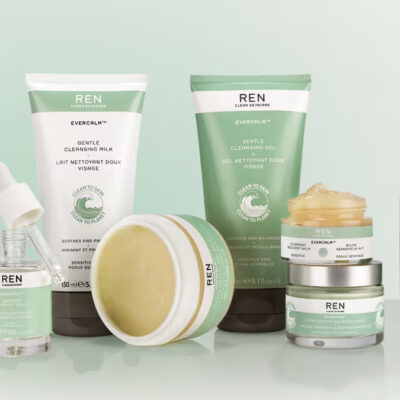
As Fintech Recalibrates, Brands Share Their Experiences With CPG Lenders Born In DTC Boom Times
Earlier this year, reports circulated that Ampla, a lender to consumer brands, was struggling financially and looking to sell. Ampla’s struggles succeeded CircleUp ending its consumer brand lending practice and being acquired by financial data and intelligence platform Brightflow AI last year. Another one-time player in the consumer brand lending business, Amazon has quietly exited the alternative capital ranks. Remaining players are increasingly tightening their lending requirements.
Amid the shifts in the financial technology segment, we decided to check in with beauty and wellness brands about the impacts they’re having on business. For the latest edition of our ongoing series posing questions relevant to indie beauty, we asked a dozen brands the following: What’s your experience with lenders such as Ampla, Settle, CircleUp, Amazon, Wayflyer and more? What lessons from your experience guide your debt strategies going forward? How have the struggles some of the lenders are facing affected or will affect the consumer brand landscape?
- Sergio Tache Founder and CEO, Dossier
We worked extensively with Clearco, Shopify Capital and Wayflyer. My experience has been good overall. They provide an important service that other traditional lenders do not cover.
There are important differences between the providers, and that’s the first thing one needs to understand. Clearco provides you with “debt” (usage of quotation marks explained later), but loaded on a virtual card. Their fees are very high, but they decrease by 50% (the exact calculation is a bit more complicated than that, but that’s the gist of it) if you spend it on performance marketing. This is somewhat limiting.
Shopify Capital provides straight up cash and so does Wayflyer. Shopify Capital has more expensive fees than Wayflyer, so we mostly used Wayflyer.
This is not a debt in the traditional sense of the word. You pay back as a function of your performance. They take a percentage of your daily revenues for reimbursement. This is super important to understand since you could end up paying your debt very quickly if you perform well as a company, and, vice versa, if you’re not doing well, you don’t have the pressure to pay it down quickly.
Overall, it’s important to have at least a sense of how quickly you anticipate to pay the money back as a function of anticipated revenues. Then, when you transform the “fee” they charge you into annualized interest, it can come out super high as a function of performance.
Incidentally, they categorically refuse to use the word “interest” at any time of any conversation probably for legal reasons since 1). it’s true that it’s not a debt in the traditional sense of the word (it’s called a merchant advance, and it has a fixed fee associated with it) and 2). they would probably be afoul of some usury interest rate laws in some states.
Once I understood the variability of the reimbursement schedule, I pushed for a cap on what I would pay down a month, so best case I reimburse the facility after six months (or more, if I perform poorly). This at least gave me some visibility on my cash outflows and more certainty.
Four lessons I’ve learned:
- Understand how you actually receive the cash (on a card versus straight-up cash).
- Try and get more certainty on reimbursement cash outflows (caps on monthly outflows to get to a minimum reimbursement period of six months or even more if you can).
- Calculate a theoretical interest rate and compare offers.
- You will have to pay this “debt” back quickly (six months is very short for a “debt”). Therefore, it’s important to understand how to use it and when. Its best use tends to be working capital (i.e., build up inventory for spike periods). We’ve mostly used these companies to help us build inventory for the peak periods like the fourth quarter/Black Friday.
Overall, these companies perform a very important service. They give liquidity to companies that would have a very hard time accessing traditional debt markets. The process is incredibly straightforward and fast versus a traditional loan. I would highly recommend using them with the caveats I mentioned above.
- Jessica Morelli Founder, Palermo Body
While we do not currently have a loan with the mentioned lenders, I have explored their loan options numerous times over the past few years, ultimately deciding not to proceed due to the unfavorable terms.
Debt requires discipline and a strong grasp of your financial forecasts, but I firmly believe it's an essential tool for business growth. It's disappointing that there are so few viable options available for businesses in a high-growth phase.
With the landscape of raising capital rapidly evolving, it's clear that there needs to be a more accessible way for growing businesses to obtain the funding they need. The lenders in question present themselves as a favorable alternative for raising capital, but the high rates and restrictive payback terms can be crippling for businesses that rely on cash flow for growth.
Without a more sustainable solution, we risk undermining the entrepreneurial momentum that has driven so much of the innovation and growth we've seen in the past decade.
- Sheena Lister Founder and CEO, The Barb Shop
I have been using Shopify Capital since launching The Barb Shop. They have been a great partner and easy to work with. While they are technically "more expensive,” they don't require a credit check, the decision and funding turnaround is super quick and efficient, and the financing formula is straightforward.
That said, the more you take out, the more it impacts your cash position. I have tried to limit the amount I take, even though the offers may seem very tempting. Overall, I am a huge fan of Shopify Capital. Hot tip: Reach out to a Shopify rep as they can usually get you better rates.
I also use Settle. I got connected with them through a friend I trust. I like Settle because they offer you a line of credit and fair payback terms based on your business history, but you aren't required to use all of the line of credit. Settle essentially pays bills upfront, so we have been using it to finance inventory.
The only thing I don't like about Settle is money flows through a holding account. This isn’t always the case and depends on your terms. Shopify disperses and withdraws funds daily, whereas Settle's payout happens once a week.
To be honest, if I didn't have a personal connection to Settle, I think I would have been wary. Since some of these lenders are new to the game, it can be nerve-wracking handing over your business's financial info and data. On the flip side, these lenders can be instrumental in helping a business grow as they have been for us.
Hard times call for creative funding solutions, so I ultimately think these new age consumer lenders have been a necessary evil for many brands over the last few years.
- Natalie Waltz Fretwell Founder, Tabu
At Tabu, we partnered with Clearco during a particularly dark time. We had a product and a brand that was resonating, but cash is king as they say, and we simply didn’t have enough in the bank to keep going business as usual.
The tricky part about paying back your debt every day is it’s incredibly difficult to just take out one advance. You end up hooked on what can be a dangerous drug.
It was absolutely a lifeline for us, but it was also extremely expensive. Watching the money come out of our account daily, it didn’t take long for me to realize that this wasn’t sustainable.
We were fortunate enough to white knuckle ourselves out of it, but that wouldn’t have been possible if we weren’t already a lean team (two full-time employees) with a healthy margin on our product. To survive, we had to be exceptionally judicious with our cash, ignore all of the flashy stuff our competitors were doing and build a sustainable brand.
In my view, that flashy stuff is what caused the rise of many of these consumer lenders in the first place. For many years, consumer brands had this grow-at-any-expense mindset. With easy access to capital, profitability was a later problem.
That type of environment creates a keeping-up-the-Jones dynamic that’s not only difficult to ignore, but almost impossible to compete with. If my competitor doesn’t care about building a real business, the price of advertising whether that be on Meta or via influencer marketing is artificially inflated.
While we hopefully won’t have to use this type of financing again, I’m grateful for the experience because it forced us to build a real business. As a profitable brand, we were able to attract a true lending partner, Bottleneck Capital, and we can now leverage debt in a healthier way.
- Sheena Brady Founder and CEO, Tease
The reality is that most self-funded early-stage businesses cannot access reasonable capital from traditional institutions, especially underrepresented groups who face systemic and traditional barriers.
I have intentionally chosen to not take on external investment from angels/VCs as I am of the mindset that for my business, 100% control over how I build and grow the business is better left to me. The cost of that decision in being bootstrapped and independently owned means taking on loans from time to time.
Despite being profitable, Tease did its first half a million in revenue with a $1,000 secured visa. It was a nightmare managing cash flow and held back our growth substantially.
We had no choice but to pursue "B lenders,” with rates as high as 20% and daily repayment terms. That was years ago, and I've seen a lot of changes since then with these lenders based on the unsolicited offers that hit my inbox from time to time. They are less predatory and more data driven (i.e., determining more reasonable risk profiles by analyzing your actual revenue data and cash flow).
Fortunately, we've since established longstanding relationships with our banking partners, and haven't accepted capital injections in some time from B lenders, though I have entertained a few calls to weigh cost benefit scenarios. B lenders might be more expensive, but they'll often issue a term sheet 10X quicker than a bank with no personal guarantees, for example. That might make more sense at a period in time for a business.
My main factors when considering taking on debt from any lender at this point:
- Getting super clear on what I need it for. To finance a PO? Working capital? New product launch? Then, get even more clear about how much we might need, how soon and what it will cost the business to execute if applicable.
- For example: If it's to finance a large PO, I am going to find a way to bake in some of that interest cost into the actual PO itself. It might mean charging more for our products. It's important to think about how you can offset or pass on the costs of taking on debt in any scenario.
- If it's to purchase inventory, I am going to negotiate higher volume manufacturing, expecting reduced costs from our manufacturers, which, in a best-case scenario, the debt helps to not only lower our COGs, but also increase our margins to support the repayment of the debt.
- How will the debt look on our books? Your debt-to-equity ratio needs to be in check. General consensus is that this should not exceed 2.0, but can vary by industry. Having too much debt may prevent you from having the ability to scale, raise investment funding or provide a healthy exit from your business. (I know a founder who sold their company for $800,000. Sounds impressive, except they had about $700,000 in debt/liabilities, so they didn't walk away with much considering the blood, sweat, tears poured into their business for five years)
- Analyze cash flow: Ensure I have enough cash coming into the business to make the loan repayments. If you don't, you're getting yourself into a hot water situation. Unfortunately, I think many founders accept any loan on any terms to stop the current bleeding in the business, which does not help if you are stretched too thin to cover your general expenses in addition to loan repayments.
- Get money when you don't need it. This is what I'd recommend to any founder the moment the find themself in that ever so brief at times moment of financial balance. You are far more likely to be in a position to get the best terms and interests rate from any lender when they see there isn't too much strain on your business. That is a fantastic time to get a rainy-day loan. The interest is a business expense at the end of the day, and you can sleep better knowing that, when you need cash, which eventually we almost always do, it's there waiting for you.
- Getting super clear on what I need it for. To finance a PO? Working capital? New product launch? Then, get even more clear about how much we might need, how soon and what it will cost the business to execute if applicable.
- Nora Schaper President, HiBar
We have looked into lending opportunities through Shopify and Amazon. We have decided not to move forward with any of these opportunities mostly because they are not approved without a personal guarantee, business credit that we are still building or a higher than usual interest rate. They also take a percent of monthly sales going forward until the debt is paid off.
As a self-funded brand, we determined that the sales cash flow was worth more than getting the loan at the offered rates. We also self-manufacture, so we try to look into ways of getting financing through equipment loans or other options with better terms for the health of our business.
- David Gaylord Co-Founder and CEO, Bushbalm
These lenders are potentially fine in a pinch, but, overall, the rates are significant. The way they sell you is by disguising the rates to appear lower.
We've worked with our bank on a line of credit and Business Development Canada (BDC) on a business loan. Both have more favorable rates, but take more to get approved.
It's always tradeoffs, but one thing I'd recommend to think differently is prioritizing cash-flow analysis. By understanding your cash flow, you can better plan your needs and be proactive about a business loan or line of credit.
- Tai Adaya Founder and CEO, Habit
I've used Shopify Capital and Stripe Capital. I recommend both of these revenue-based lenders. I have used Clearco. I do not recommend them.
A lot of these lenders have gone out of business (Ampla, CircleUp) or drastically changed their business models. These companies were ZIRP [zero interest rate policy] phenomena –– traditional predatory loan companies with modern branding.
I prefer revenue-based, reputable providers like Shopify, Stripe, Amazon, private (relationship-based) credit or your bank.
- Keith Cornelius Jr. President and COO, Maison 276
Although we haven't partnered with the aforementioned lenders, we have conducted due diligence. From our perspective, they function similar to conventional underwriters. While they might leverage unique access to brand data or streamlined tech platforms to request credit, they all appear to be underwriting based on profitability and positive cash flow.
If your target market is emerging consumer brands, I believe it's reasonable for these platforms to either 1). have difficulty identifying prime lending candidates, or 2). have stressed loan portfolios, especially given today's rate environment.
- Ricardo Quintero Co-Founder and President, Digital Brands and Care
In today’s lending environment, with current interest rates, it is nearly impossible to achieve a proper ROI on borrowed funds. Being self-funded, we have always prioritized profitability and simplicity.
In the past, we only worked with Shopify Capital, which offered competitive rates, a straightforward process and a manageable payback system through small deductions on processed orders.
- Shizu Okusa Founder and CEO, Apothékary
I've been an entrepreneur for the last 14 years. I started my career working in Wall Street at Goldman Sachs working on their prop trading desk where we managed and traded a $1.5 billion book of mostly distressed securities up and down the capital structure. My primary role was to hedge positions against our largest positions, mostly in high yield bonds (i.e., debt lent to riskier companies), bank loans (i.e., term or asset-backed loans to more established companies) and fulcrum debt (i.e., the most hairy part of one's capital structure, that in a bankruptcy or Chapter 11 scenario converts into equity).
We often would take positions in fulcrum debt securities to own the company via equity, after a Chapter 11 reorg. These deals/situations were incredibly hairy, but I learned immensely through these few years.
After I left Goldman, I started my first company, JRINK, a brick-and-mortar juice business and now my second business, Apothékary. We've been funded mostly through family offices, angels, strategic investors, family and founder-friendly operators and have not yet raised a traditional growth equity or venture capital round. That's not really of interest to me, at least at this juncture of the business, for multiple reasons. As a cash flow-positive business, we've opted for patient equity capital and non-dilutive financing options to fund our growth.
During 2021 to 2022, interest rates were at zero, an unheard of (and arguably, lucky!) time for many entrepreneurs and investors. We took advantage of this environment and would always couple our equity fundraises with debt capital that the business could support through free cash flow. After a ton of research, we ended up securing a line of credit with Ampla and never worked with the likes of Settle, CircleUp, Wayflyer or Shopify Capital.
The latter were all MCA or merchant cash advance fintech companies that were financing based solely on revenue and not the ability for cash flow to service the debt (i.e., how traditional debt works).
Revenue-based financing is a really hard thing to manage from a cash-flow perspective because every week the money is drawn out, and it’s super hard to predictably forecast that. You don't know what your revenue is going to be, and you often have competing payment priorities like payroll, rent, marketing, etc. In a traditional line of credit, the lending is based on your assets, AR and inventory.
In the days of zero interest, everyone was trying to make money, and revenue financing came into play with unsecured assets. That's where all of these companies have gotten into trouble, and they haven't been good for brands. We negotiated a fixed interest rate credit line with Ampla and were in a fortunate spot to not deal with increased interest expense given the fixed nature of the loan despite interest rates rising.
Looking back, I'm incredibly grateful we did this as most brands have been squeezed on rising costs and rising variable interest rates, inevitably resulting in the demise of so many companies. We have since moved on from Ampla and were fortunate to secure a new long-term commercial lender, Walden Mutual.
I am really concerned about the consumer landscape because a lot of funders are moving to consumer tech or tech versus consumer. It almost feels impossible for brands to fundraise right now with the disappearance of angels. For brands that are like sub-$5 million in revenue, it's going to be incredibly hard to get reasonable types of financing, whether it's debt or equity.
I think this is a really great time to look hard at one's business' unit economics, margin profile and how quickly it will take for inventory to turn into cash. It's really important to know, what is the worst-case scenario if something were to happen? A lot of the brands in the good days assumed revenue was only going to go up, but, in general, you want to always protect your downsides. In a downside scenario, could you even service your debt?
Internally, we've looked at a base case, bear case and bull case and have always managed the financing of the business to be in light of the entire capital structure. You can't just look at equity or debt on a standalone basis, especially in the worst-case scenario if the business faces a challenging scenario. With interest rates projected to come down this year, I do feel more bullish going into 2025 and that investors will start to look at parking their dry powder in venture again, especially if treasury yields start to not be as attractive.
- Lindsey Martin Founder, Kiramoon
We have spoken with a handful of these fintech lenders, but have found their model to be for a very specific use case. From what I've learned, the majority of them lend against your DTC revenue, and your principal is paid off over time as a percent of every order that is placed on your website.
This wouldn't be a fit for Kiramoon because 80% of our revenue currently comes from wholesale, and we are building our e-comm business on a bootstrapped budget (slowly), so our kiramoon.com sales wouldn't justify being approved for one of these loans. In our situation, a better path would be PO financing or even a small business loan to access operating capital while we diversify and balance our revenue channels.
If you have a question you’d like Beauty Independent to ask beauty and wellness entrepreneurs, please send it to editor@beautyindependent.com.






Leave a Reply
You must be logged in to post a comment.